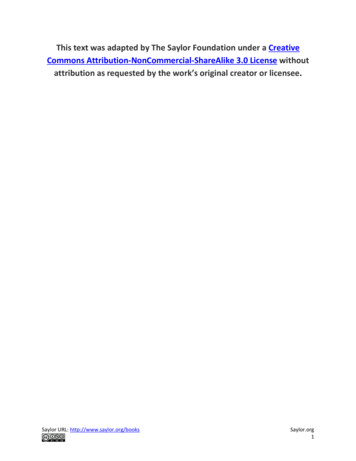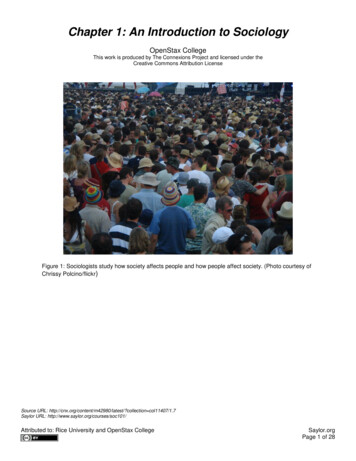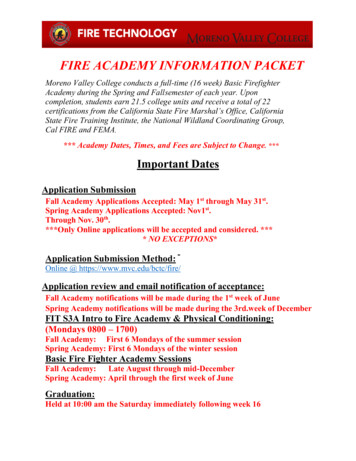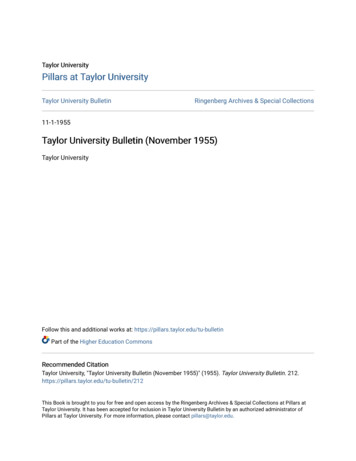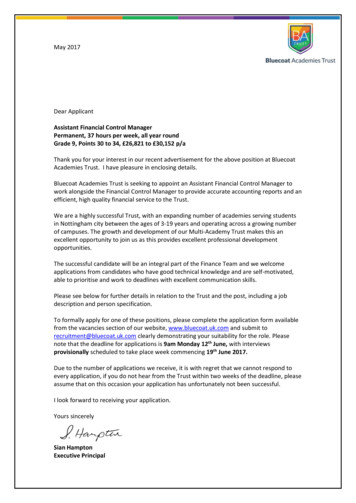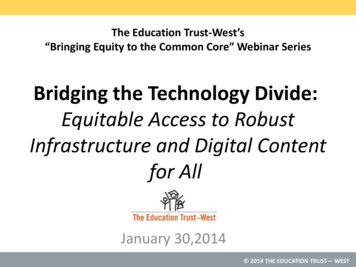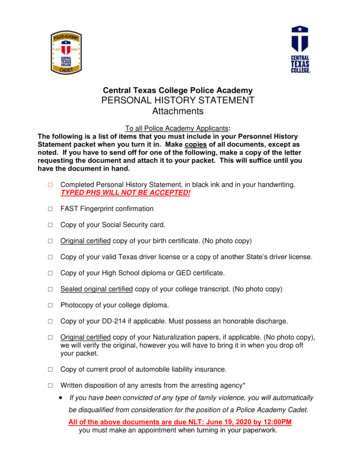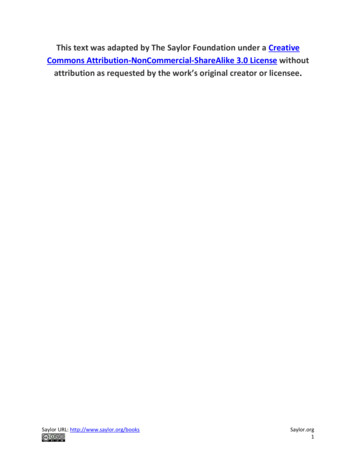
Transcription
This text was adapted by The Saylor Foundation under a CreativeCommons Attribution-NonCommercial-ShareAlike 3.0 License withoutattribution as requested by the work’s original creator or licensee.Saylor URL: http://www.saylor.org/booksSaylor.org1
PrefaceBook Design ProblemWe set out to design an introductory course governed by four themes:1.Give students a good idea of what a career in MIS looks like by doing MIS.2. Enhance the professionalism of deliverables by teaching design and usability concepts.3. Promote creativity by assigning projects that demand it.4. Teach students about cloud computing by having them do cloud computing.Students in an introductory Management Information Systems (MIS) course often ask what a career inMIS looks like. Lacking a clear vision, they make their own assumptions. Often they assume the careerinvolves programming with little human interaction. That MIS is a technical field could not be furtherfrom the truth. MIS job descriptions typically require candidates to be able to collaborate, communicate,analyze needs and gather requirements. They also list the need for excellent written and communicationskills. In other words, MIS workers are constantly interacting with other people both inside and outsidethe organization. They are coming up with creative solutions to business problems.This course is designed to help students get a feel for what a career in MIS would be like. Our studentsreport that they learn more about information systems from their internships than from their IS courses.Consequently, we designed a course that looks very much like an internship—an introduction to the fieldfollowed by a substantial project.Chapter 1 begins by introducing the information systems landscape. Here we discuss all the usualsuspects: the information systems triangle, the systems development life cycle, transaction systems (ERP,SCM, CRM), collaboration systems, and business intelligence systems. Other aspects of the landscapesuch as usability, outsourcing, database concepts and so forth are introduced throughout chapter inChapter 2 where they fit in naturally with the flow of the project.Saylor URL: http://www.saylor.org/booksSaylor.org2
Chapter 2 is the substantial project which runs over a number of chapters. Over the course of thesemester, students plan, build, and develop a proposal for an iPhone application. They develop a veryrealistic mockup. They also build a website to help market and support the app. Students are engagedbecause the project is fun and feels real. However, they are simultaneously learning business concepts andMIS skills. Prior to the existence of this course, we were only able to give such an interesting project at thesenior level. Now, even as freshmen, students have a real experience of MIS in operation.A by product of creating an engaging course is increased enrollment in the MIS major. Even students whohave never heard of MIS become excited about the major and either switch majors or add it as a doublemajor or minor.Many other books have students study tools and then do a case. By contrast, most of this book is a case.Much like the real world, we introduce tools when needed, and only to the extent needed, to get at eachpart of the case.ConstraintsThe design team embraced a number of constraints in creating the book. We acknowledged that this is asupport course in terms of skills development for the other business disciplines—accounting, finance,management, and marketing. Students should walk away with skills that they can take into the otherdisciplines. The course requires mastery of a number of software skills—primarily from the MicrosoftOffice suite. These include skills in PowerPoint, Word, and Excel. We assumed no prior backgroundknowledge on the part of the students. Our experience is that students entering college have exposure tosoftware skills, but not a mastery of applying those skills to solve business problems.A number of skills are also learned about cloud computing. These include Web site design anddevelopment (Google Sites, Google Gadgets, Google Docs), Color Management (Adobe Kuler Color),iPhone App mockups (MockApp), and online polls (PollEverywhere).The book was designed for both in class and online delivery and for small and large section sizes. The nontraditional student population is a growing sector and many of those students choose to learn online.Saylor URL: http://www.saylor.org/booksSaylor.org3
Finally, the book needed to appeal to the business side of information systems. We accentuate the creativeaspects of the field rather than casting MIS as an overly technical, nerdy, machine-oriented discipline.Values, attitude, approachWe began with the assumption that MIS is an exciting discipline. Nonetheless we recognized the difficultyof conveying that excitement—especially in a skills book. However, difficult does not mean impossible—and we believe we have created an elegant solution. We hold that learning can be both challenging andfun. Research clearly shows that students want to be challenged in meaningful ways. Finally, we assumedthat students recognize and want to emulate good graphic and information design. This is an imageconscious generation with a keen eye for what looks cool. Why not build a book that capitalizes on the eyefor graphic design that students already bring to the table?Book Design InfluencesWhile our background is in MIS, we believe that one of the strengths of the book is its ability to lookoutside the field for inspiration. We were influenced by a number of writers in the development of thebook.Edward Tufte (The Visual Display of Quantitative Information) is perhaps the world’s leadingexpert on the design and display of quantitative information. Tufte begins by insisting we focus first onthe quality, relevance, and integrity of the content. He has an especially sensitive eye for the ethicaldimension—telling the truth in an information display. Good content is followed by the creation of a gooddesign to communicate that content.Robin Williams (The Non-Designers Design Book) gives simple but effective design rules that can beapplied to document design, presentation design, website design, even spreadsheet design. Followingthese rules students are able to create professional displays of information.Students will use PowerPoint both in college and the workplace. Why not learn to use it effectively? Twowriters were especially helpful in this regard. Both are pioneers in the effective construction ofSaylor URL: http://www.saylor.org/booksSaylor.org4
PowerPoint presentations. Garr Reynolds (Presentation Zen) promotes a heavy use of images inPowerPoint. Nancy Duarte (Slide:ology), provides a comprehensive list of design guidelines.Organizing framework for the BookOur organizing framework for the book revolves around the importance of design. We want students to becreative, design like professionals, and take pride in their work. We challenge students to producedeliverables that are professional in both content and style.Problems must be thoroughly analyzed before a proper solution is designed. Information is a core asset,not only in information systems, but to most organizations. It is safe to say that most students willregularly be creating information displays as part of their jobs following graduation. Why not get acompetitive advantage by learning how to create them in a professional and effective fashion? We includesections on graphic design—a subject that students find to be very interesting and marketable.The importance of design lead us to adopt the Systems Development Life Cycle for the assignments. Inthis way, students are asked to be intentional about their design choices, relating them back to therequirements that they uncovered earlier in the project.Book Guiding PrinciplesWe developed a number of guiding principles in the creation of the book. We began with creative, rightbrain problems. The business curriculum is so heavily focused on analysis that there is little room forcreative expression. We have students design and draw with the software to remedy this problem. Forexample, students design an iPhone App in PowerPoint and simulate its operation with hyperlinks.We want to support and model critical thinking. There are many definitions of critical thinking and we donot claim to have the most comprehensive one. However, we believe that the explanatory frameworkoffered by Richard Paul is especially powerful. Paul encourages faculty to communicate concepts in fourforms—definitions, rephrasing, written examples and illustrations. The hope is that one or more of theforms will stick and mutually reinforce each other in the student’s mind. Students frequently commentSaylor URL: http://www.saylor.org/booksSaylor.org5
that they see the value in what they are learning and are able to apply it not only in their other classes, butalso in real life.Finally, we think that the book should support multiple learning styles. We use Neil Fleming’s taxonomyof learning styles: Visual, Auditory, Read/write, and Kinesthetic (VARK). Different students learndifferently; this book contains something for everyone.Architecture of the BookWe align the architecture of the book with our guiding principles. For example, all the book’s conceptsand software skills are presented in a critical thinking format. Each concept is defined, rephrased “inother words,” bolstered by an example, and then illustrated. For software skills we repeat the samepattern in a different format. We construct a captioned screen shot. The caption contains the first threeforms—definition, rephrasing, and written example. The screenshot contains the illustration. A great dealof work went into the digital manipulation of the screenshots to support our pedagogy. The actions areexpressed with a near wordless lexicon. Symbols in the lexicon have an Anime or Comic Book feel in orderto create a counterpoint and stand out from the screen shot. And frankly the Anime feel is just fun. Toaccommodate online learners the skills are also modeled through video lectures.Problems in the book progress from challenging students to imitate best practice to creative application ofthe concepts. So many times we have seen assignments where students are asked to do either too little andthus the students get little value or the students are challenged but not given the proper ramp up. Ourleveled approach is a good meeting in the middle—challenge with support.Since we set the bar so high for the professional quality of deliverables, we had to provide a way forstudents to meet that standard. What we developed is a progressively challenging pedagogy. Byaccomplishing the Level 1 and 2 hurdles, students prepare themselves for a comprehensive Level 3project.Introduction: Each chapter begins with an introduction to outline the chapter. The introduction also sellsthe practical value of the chapter to the student’s future career. Selling the chapter achieves buy in andSaylor URL: http://www.saylor.org/booksSaylor.org6
creates motivation to succeed. Establishing the practical value of the chapter also lets students know thatwe care about their future.Following the introduction, we present the theory behind the chapter. The theory is carefully introducedto scaffold on prior knowledge while extending that knowledge much further. We cover best practice inindustry and illustrate it using good and bad examples.L1, L2, L3 Creative Application: The Level 1 and Level 2 assignments incorporate analysis andrequirements stages. The Level 3 assignments focus on design. Students must analyze the problem, gatherrequirements, design a solution, and develop the solution. Students are encouraged to exercise creativityboth in their deliverable and in their written support for the deliverable.Diagrams: We show abbreviated techniques to accomplish each of the tasks required in the assignment.Furthermore, the techniques are shown in no particular order. Students need to discover what they needto accomplish and then look up the techniques that will help to get them there. Over the years, we havelearned that students can learn a technique very quickly, but this is not what they truly need tounderstand. They need to know when to apply the technique, and this pedagogy focuses on developingthat intuition.Sometimes, we show before and after examples of the required deliverable. Students are challenged totransform the before into the after using the techniques. We expressly avoid the step by step exercisesfound in many other texts. Our experience is that students will focus on keystrokes rather than conceptswhen presented with step by step instructions.Our model is closer to just in time learning found in many MBA programs. It is also a model for life-longlearning, rather than learning specific software tools.ConclusionWe have learned a lot over five years developing this book, and continue to learn every day as we moveforward. We would like to thank our students who have helped guide us with their feedback. We willSaylor URL: http://www.saylor.org/booksSaylor.org7
continue to make improvements to a project that will never be entirely finished. However, this much weknow—enrollment has dramatically increased in our department (400%).Saylor URL: http://www.saylor.org/booksSaylor.org8
Chapter 1Information Systems in Your Life: Types of Systems andCareers1.1 What Are Information Systems?LEARNING OBJECTIVES1.Understand the parts of an information system2.Identify companies that practice user centered design3.Identify typical careers for information systems graduatesIt’s More Than Just ComputersInformation systems are the combination of people, information technology, and business processes toaccomplish a business objective.Every information system (IS) has people, processes, and information technology. In fact, many ISprofessionals add most of their value working with people and processes. They manage the programmersbut typically avoid programming themselves. We can represent an information system as a triangle withpeople, processes, and information technology (computers) on the three vertices. The three parts of aninformation system are often referred to as theinformation systems triangle.Consider the popular trend of letting the TV audience vote on some talent shows such as Dancing with theStars. The voting is managed by a sophisticated information system. The voters are the people involvedwith the system. Voters can cast the votes by phone, by text, or by online poll—three different informationtechnologies. A central server at ABC records and tallies the votes. The business processes include thephone, texting, and online procedures—how and when to cast votes, and rules limiting the number ofvotes from each household.In November 2010, ABC had to defend the legitimacy of its business processes when detractors claimedthat Bristol Palin, daughter of political candidate, Sarah Palin, received an inflated vote tally from TeaParty supporters. Some of these supporters bragged on blogs about how they had circumvented the ABCSaylor URL: http://www.saylor.org/booksSaylor.org9
business processes to record multiple votes for Bristol. ABC claims that it has systems in place to spot anddiscount suspicious voting activity. They have publicly revealed some, but not all, of these fraud detectionsystems. At this point we don’t know for sure if fraudulent votes got through. For more on this story seefor example: in-tea-party-voting-conspiracy/.The three parts of the information systems triangle must interact in concert to realize businessobjectives. The job of the IS professional is to ensure that a balance is maintained and enhanced forthe good of all the actors and the business as a whole.Good and Bad Information SystemsInformation systems professionals work with others to design and customize the systems that you interactwith everyday. When you register at a hospital, the information goes into an information system designedto support administrative reporting and insurance processing. When you buy fromAmazon.com, theinformation goes into an information system designed to support customer relationship management.Every information system is designed to make someone’s life easier. Unfortunately, that someone is notalways the consumer. When was the last time that you had a good registration experience at a hospital?Saylor URL: http://www.saylor.org/booksSaylor.org10
That system probably was not designed with you in mind—but rather designed to support backendreporting for the hospital administration and by proxy for the government and insurance companies. Sothe administrators are happy, but not the customers. From the hospital’s point of view there is nobusiness need to make the registration experience extraordinarily pleasant. They are betting that you willnot choose your hospital based on how difficult it was to register.Amazon.com, by contrast, delivers an extraordinary experience to its customers so that they will stayloyal. Amazon practices user centered design—designing to meet the needs of the user. However, theclever folks at Amazon also have tremendous backend reporting. So it is possible to design systems thatplease customers and administrators simultaneously—but it takes a bit more effort.What would hospital systems look like if they were designed to Amazon standards? Imagine 1-clickappointments, 1-click payments, shielding the client from the insurance companies. How about anintegrated patient record of all past procedures?The world will continue to gravitate toward Amazon style systems. In the end it is good business to makeeveryone happy—employees, customers, and administrators. It is also the right thing to do. Think back tothe hospital. In a competitive market, maybe you would choose the better customer experience. A hospitalworker might choose to work for the hospital with the more user friendly patient information system. Noone likes to be yelled at by unhappy customers.It doesn’t take much to improve the user experience (UX) of a system. You have to design a user interface(UI) anyway—why not make it a good one? In the words of Hall of Fame basketball coach John Wooden,“If you don’t have time to do it right, when will you have time to do it again?”Consider the tremendous success of Apple Computer. One of the main advantages that Apple has over itsrivals is that it carefully analyzes how people best interact with technology, develops requirements basedon that analysis and then designs elegant computers, the iPhone, iPad, iTunes, and so forth based onthose requirements.Saylor URL: http://www.saylor.org/booksSaylor.org11
Google Health, pictured here, has created a user centered patient record—and for free! It will beinteresting to see if hospitals adopt it.Most Professions Use Information SystemsMarketing, accounting, finance, manufacturing – there are many different professional goals and types ofwork in the business world. There are also many different industries where this work can be performed –manufacturing, retail, banking, healthcare. No matter what your career goal is or what industry interestsyou, your success and the success of the business rely on your ability to recognize opportunities whereinformation systems can be used to improve performance. In most lines of work, you will need to storeinformation in and retrieve information from databases. You will have to create persuasive andprofessional reports and presentations to convince others that your ideas make sense. Using MicrosoftExcel and other tools, you will analyze data to find patterns and trends to aid decision-making. You willmanage your relationships with contacts and clients using customer relationship management systems.The business’s success will depend on you leading efforts that use technology to support the introductionof new products, efficiently manage supply chains, and effectively manage complex financial activities.Retailers rely on past purchase data to develop sales forecasts and predict purchase behavior. Mostbusinesses utilize collaboration technologies to bring together employees from all over the world to solveSaylor URL: http://www.saylor.org/booksSaylor.org12
problems. Your ability to recognize opportunities to use information technology to create business value iscentral to both your success and that of your firm.What Does an IS Career Look Like?A career in information systems is full of action, problem-solving, and teamwork. It is the goal ofinformation systems professionals to bridge the knowledge gap between business users and technologists,and thus IS professionals must be fluent in both worlds. Work in the field of information systems isexciting, fun, and fast-paced. There is always a new team to work with and new technology to learn about,and projects move quickly leaving openings for new endeavors. In a recent report published in The WallStreet Journal, information systems professionals were tied for the highest percentage of collegegraduates that were satisfied with their career path. See 111000/psych-majors-not-happy-with-options?mod edu-continuing education.When preparing to become an IS professional, students focus on learning about the types of systems thatexist, what they offer to businesses, best practices for implementation, and the advantages anddisadvantages of each. Students also focus on how to work with business users and discover what theirsystem needs are and how they can best be served by information systems. Information systemsprofessionals focus on solving problems in businesses through the use of information systems.When students start their careers, they frequently work on teams that connect businesspersons with theappropriate system solution for their situation. Usually the organizations they work for adopt a set of bestpractices to create consistency across project teams. Through the use of these best practices, ISprofessionals determine what options are available, consider the pros and cons of each, design acustomized solution to match the specific business, and develop a plan on how to best implement theinformation system, including rollout phases and training.As mentioned, IS professionals typically work in teams. This is because the projects are usually very largeand have many interworking pieces. As a result, IS professionals specialize in a particular type of workand contribute their expertise in this area. Specializations include system analysts, software developers,database administrators, and project managers.Saylor URL: http://www.saylor.org/booksSaylor.org13
Information systems as a career is attractive to many individuals because of the traits above. However, itis also engaging because it is a career in which you get to work on making people’s lives easier. ISprofessionals focus on developing systems that businesspersons will use to create efficiency and increasetheir performance. IS professionals design systems that help businesspersons make better decisions(decision support systems) and lead organizations (executive dashboards). Systems are also created tokeep track of materials (supply chain management systems) and customers (customer relationshipmanagement systems). And given the important role of information in modern organizations, ISprofessionals record, monitor, and analyze data to learn how the business can improve (businessintelligence systems). IS professionals work to design these systems to be more usable, more efficient, andmore informative. This book will discuss these topics and allow you to experience many of them. It walksyou through what it is like to be an IS professional, rather than telling you about it.KEY TAKEAWAYS The information systems triangle includes people, processes, and information technology. It is a goodreminder that MIS is about much more than just technology. Well designed information systems keep the user in mind at each step of the process. Information systems are used by every functional area of business—marketing, management, finance,and accounting. For this reason it is good to have a strong background in information systems. Careers in information systems tend to be dynamic, team based, and focused on problem solving. Few information systems careers involve programming. However, IS professionals must be able tocommunicate with programmers.QUESTIONS AND EXERCI SES1.Search for news stories on the Bristol Palin vote controversy. What systems did ABC put in place to catchvoter fraud?2.Pick a user centered web site other than Amazon.com and explain why you think it is well designed.3.Find job descriptions for two information systems jobs. Do the job descriptions emphasize soft skills ortechnical skills or both?Saylor URL: http://www.saylor.org/booksSaylor.org14
1.2 Designing Information SystemsLEARNING OBJECTIVES1.Compare and contrast usability, graphic design and analytical design.2.Outline the steps by which an information system should be designed.Many Meanings of DesignThe key to successful information systems is good design. But what makes a good design? A number ofdisciplines weigh in on this topic. We will look at design from a number of different perspectives.Whenever possible we will contrast good and bad designs.Different people use the word design in different contexts. When IS professionals speak of design, they arereferring to business processes. Problems must be analyzed and requirements documented beforesolutions are designed, developed, and implemented. After all if the design does not satisfy the businessneed, then what’s the point? However, satisfying the business need is really a baseline standard. Thevilified hospital system described earlier meets the business need of registering patients. And yet itsdesign is in other ways lacking. Similarly, fast food meets the need for feeding one’s hunger. However, wewant to be metaphorically better than fast food in our designs.Usability describes how easy the system is to navigate. The easier the system is to navigate, the less time auser will need to spend learning to use the system. A more usable system also leaves less room for error.Usability theory provides rules of thumb (heuristics) that document best practice conventions fordesigning a user interface. Amazon.com has one of the most usable online systems because they followestablished conventions. Following conventions tremendously increases the potential acceptance of yourwebsite or app.Graphic design refers to the visual appeal and organization of the user interface. There is obviously someoverlap here with usability. Usable systems typically adhere to at least some graphic design rules.However, a usable system could be bland and uninteresting. Employing graphic design principles helpsensure that the system will have visual appeal. Designs also need to fit with the overall brand of the client.Existing colors, fonts, and logos are all a part of the brand for which the system is being created.Saylor URL: http://www.saylor.org/booksSaylor.org15
Analytical Design describes how to best represent information—especially quantitative information—tocommunicate clearly and truthfully. Every information systems project has quantitative dimensionsassociated with project management. These include estimating costs, time schedules, and so forth.The convergence of usability, graphic design, and analytical design on Yahoo Finance. This graphshows the three month stock price for Amazon vs. Google. From a usability standpoint it could notbe easier to request the graph. Type the company name and it suggests the stock ticker symbol.Also, as you move your cursor (the hand), the black dot on the line moves as well, and the numberson the top left update to display values for the date you are passing over—very slick! The graphicdesign is excellent—muting the underlying grid so that the data stands out by contrast. Theanalytical design is also first rate. Hundreds of data points are effortlessly represented. We see thetrading volume on each day. At the bottom, the stock price is placed in context over a multi yearperiod. In sum, we have a tremendous amount of information beautifully represented withoutclutter. Think about this the next time you see an impoverished PowerPoint graph with four barsrepresenting four data points.Saylor URL: http://www.saylor.org/booksSaylor.org16
Systems Development Life Cycle (SDLC)Information systems are designed using the systems development life cycle (SDLC). The SDLC is to alarge extent common sense spelled out in stages. First, analyze the current situation. Then specify therequirements that a solution should embody. The next stage is to design a solution (no programming yet).Then the system is developed (programmed) and tested. Finally, the system goes live for the end users asit is implemented in the business setting. To review, the five phases are:1.Analysis2. Requirements (vision of future state)3. Design4. Development5.ImplementationIn this course we will cover all five stages. However we will focus most heavily on the first three stages fortwo reasons. First, because that is where IS professionals tend to spend most of their time and secondSaylor URL: http://www.saylor.org/booksSaylor.org17
because it is much easier to make changes to a system when in the planning stages, than after code hasalready been generated.It is good to frequently interact with the end user and show them screen mockups anda systems architecture diagram of what the final system will look like. The systems architecture is ahierarchy diagram of the flow of the website or app—what the relationship between the pages of thesystem will be. It is sometimes called a site map. Ideally the systems architecture is done on paper withsticky notes that can be moved around at will by multiple users. A final s
expressed with a near wordless lexicon. Symbols in the lexicon have an Anime or Comic Book feel in order to create a counterpoint and stand out from the screen shot. And frankly the Anime feel is just fun. To accommodate online learners the skills are also modeled through video lectures.


